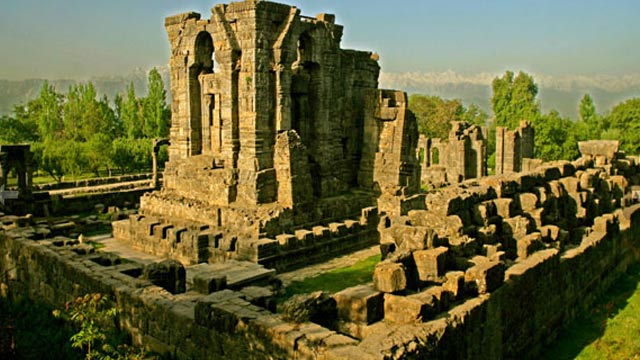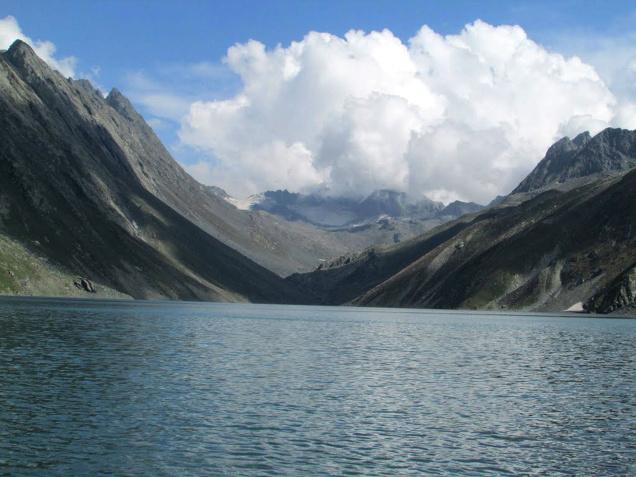Kashmir is a wide and vast valley between Mid Himalayan Mountains and looks like a square or a parallelogram in shape. According to KhawajaAzam, from the Eastern to the Western boundary it measures about 40 farsak (1 farsak = 18000 feet or 2.5 miles) in length and from the South to the North there is a difference of 7-8 farsaks. As per the European surveys, the Srinagar city is at an altitude of 5200 feet. The surrounding mountains which encompass it like a fort vary from 8000-17000 feet in altitude. Due to its location, Kashmir experiences snowfall for one-third of the year. The tall and towering mountains whose height exceeds 3000 ft are perennially snow-covered up to the height of 1300 ft the snow often melts.
Origin of Kashmir as per Hindu Researchers
The author of Nilamatgpurana narrates that in the ancient past, Kashmir was a vast lake engulfed by tall and towering mountains. The lake was full of transparent waters, due to the melting of snow, which after flowed through streams stored in the lake. There was no outlet for the drainage of the lake water, as the valley was closed from all sides. In those times, the peak of the Harmukh Mountains was the abode of Mata Sati alias Parvati. She used to visit the mountains of Kousarnag on a boat. The lake was called Satisar, as in the Sanskrit language “Sar” stands for the lake. In those times; a demon called Jalodev, who was strong, horrific, and brave, used to live in the lake. The demon used to worship Brahma, earnestly and ardently in his early stages of life and he was gifted with the power of overpowering any attacker in the waters of the lake. Later on, the demon used to live in Satisar and was confined to the peaks of mountains and in this way, he took a toll on the creatures and was responsible for the death and destruction of mankind.
Once the grandson of Brahma, Kashapraksher, after visiting the various parts of the world, arrived at Satisar, and on seeing the mighty mountains, and the fresh breeze of air, he shouted with excitement that if there is heaven anywhere on the earth, it is here i.e. Kashmir.
Around the lake, he was surprised to see no trace of the human population. He came to know about the tyranny and destruction of Jalodev from an old man. He constructed a temple at Nowbavdan which lies in the middle of Kousarnag and in the vicinity of Hirapora. He offered his prayers for one thousand years and during that period he prayed for the death and destruction of the demon. His prayers were answered; Brahma deputed Bhishan and Mahesher to kill the demon. All the three saints were fighting against the demon for a long period but were not successful to finish him. Whenever the demon was overpowered by the saints he hid underwater, since the lake was his hideout and the blessing of Brahma his security. At last, Bhishan was successful in draining water through an outlet that he made with an instrument called Sudarshan Chakkar near Baramulla. The hard rock’s disintegrated and the water level of the lake receded, but the demon hid under the lacustrine deposits. Both Bhishan and Mahesher left for their settlements but soon Jaladev resorted to his old follies and water again came to ooze out from his place of hiding which covered the surface of the lake. Kashapraksher again offered his prayers for the destruction of the demon. Soon Myna (Haer, in Kashmiri) a piece of rock from Summer mountain in his beak was flying and dropped the same on the sport, where the devil used to rest, resulting in the death of the demon and water stopped oozing out. The piece of that mountain is nowadays called Hari Parbhat and the Goddess Sharika is supposed to be there. On a particular day of the year, the Hindus congregate for prayers.

After the death of Jaladev, when the water level receded, the Adiwon was the first Karewa (table land) that came into origin. (AD = first and won = land) This place is referred to as the first land when the level land came to the surface, several canals, streams, and green marks were existent everywhere. This pleased the gods who made it their resting place at various spots and in this way we do find shrines and temples in different places.
Holy Locations and Shrines
Afterward, Kashpraksher settled in this beautiful land and invited Brahmins of integrity and high moral character to settle here, and this land of flowers was named “Kashpmar”. In the Sanskrit language “Mar” stands for “Home”, i.e. the name of this country was referred to as the “Home of Kashyap”. With the passage of time, it was called “Kash mar” and with the change of language, it is famous by the name “Kashmir”.
Mullah Ahmad, (the translator of Ratan Puran) has said that one saint Amrit Sagar by name was engrossed in meditation at Vindlyachal Mountain. In that period, a wrestler Kashim Veer by name was famous for his bravery, he used to lift a stone with having the weight of 100 maunds in his hand while walking. One day this stone wrestler moved towards a mountain for hunting. Being hungry and thirsty he reached the spot of Raksheer and with authority and dictation demanded water from him. Raksheer handed over a pot and directed him towards the well. The wrestler dropped the pot in the well, and with all their might and strength, he could not lift the pot out of the well. He was surprised and after kissing his hands and feet of Raksheer, he requested him very politely. Raksheer made a call, oh mother! Give water to the wrestler. Kashmir Veer lifted the pot out of the well and quenched his thirst with only pot. Afterward, he stayed there to serve Raksheer and was engrossed in deep meditation. He always without eating or drinking was engaged in worshipping the Almighty and serving Raksheer daily. One day he entreated the magnanimous Raksheer, that in the past, he has committed innumerable sins and crimes and how to get rid of them. Raksheer said if you go on pilgrimage to Amarnath on a particular day and will beg for the exoneration of your sins you will become as clear as snow. Afterward, Kashim Veer, along with his saint decided to visit Amarnath by crossing the southern mountains and paid obeisance on a particular day and was satisfied. Afterward, he visited all the holy places situated in the mountains of Kashmir and at last reached “Koi” Tirth in Baramulla. He inquired about the characteristics of “Koi” tirth from Raksheer, who replied that in-between Satisar, there are one thousand tirths. Kashmir Veer asked, can anyone see these tirths? Raksheer said, if the water is drained out of the lake, everyone will be able to see these tirths. Kashmir Veer, said is there any man in the world who will drain water out of the lake? Raksheer said, if you pray to the Almighty for a period of one thousand years, this impossible task will become easy for you. The Kashim Veer meditated for 1000 years at Kousarnag. One day in his temple, he saw that a rat was making a hole in a vessel containing water, and water tricked out of the vessel. Kashim Veer thought it was a divine signal and by his strength, he made a hole at Khandenyar in Baramulla. By the grace of the Almighty, water started to flow out of the hole till Satisar was dry and the land surface was exposed. The internal roof of this hole was there up to the reign of Sundersain. During this period due to the earthquake, there was destruction and devastation and the city of Sandmatnagar was flooded.

When Kashim Veer arrived in this paradise, he visited every tirth here and settled here. Afterward all the Raksheers and saintly people o India arrived here and were engrossed in meditation. From different corners, Brahmins and common people who came here decided to settle here. Since this land has been famous due to the courage and bravery of Kashim Veer, it is because the people of that period named it as “Kashimar” and with the passage of time it was known as Kashmir.
A result of the records of various historians and the present shape and structure reveals that this beautiful land of flowers was all water in its initial stages and at that time people used to inhabit the peaks of mountains and used boats to travel from one side to another. In cold areas of Harmukh Mountain, Kousarnag, Dachanpora, and Lolab, there are still the fixing spots for boats, because sailors making bores in rocks tighten their boats to keep them safe and secure. This bore is called “Naukabandan”. In the Sanskrit language “Nauka” stands for the boat while “Bandhan” stands for fixing spot. In some places, the stones used as Naukabandan, are present at the spots meant for drinking water and at some places, it is observed that the water level had touched the area.
Kashmir – Its Distinct Features:
The land surface of Kashmir is very delightful and colorful. It has been referred to as the “Paradise on earth” by saints and scholars. It is the reality that its peculiar and distinct features do not find any parallel in any country in the world.
- This country has a moderate, serene, and invigorating climate which is pleasing and ideal for one’s health. There is no need for a fan or fur during summer and the cold and snowy winter season.
- This land of flowers is gifted with perennial waters from snowy mountains, springs, and lakes which flow through streams and canals. As an elixir of life, this water irrigates the cropping fields of the valley, making people happy to reap their harvest.
- On the entire land surface of this country in the vicinity of hills, mountains, streams, springs, and rivers are pastures carpeted with green grass, stretched for long distances. Due to their freshness and greenery, they look very delighted and pleasing.
- The gardens, orchards, royal palaces, tarns, streams, waterfalls, fountains, margs, the arrangement of landscape, and the abundance of trees, flowers, and green-grossed meadows are alluring and enviable.
- This beautiful land region is encompassed by mountains on all sides. These hills and mountains are pleasing and delightful, with refreshing air which spreads throughout the length and breadth of the valley.
- The green-topped hills and mountains with invigoration and the clean atmosphere provides joy and happiness to both rich and wise people.
- In this paradise, there are different varieties of fruits that are juicy and delicious in orchards on Karewas.
- Various types of crops are produced which are cheap and are available in abundance here, especially rice which is extensively being cultivated here and is the staple diet of the people.
- The forests and mountains of this country are rich in wildlife and bird population, which are used for hunting. The English people spend a lot of money visiting here and often leave with some gifts for their friends.
- There are neither dreadful beasts nor poisonous insects like snakes and crocodiles in this country. There is no danger of life from such beasts.
 Call
Call WhatsApp
WhatsApp Enquiry
Enquiry